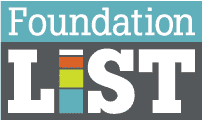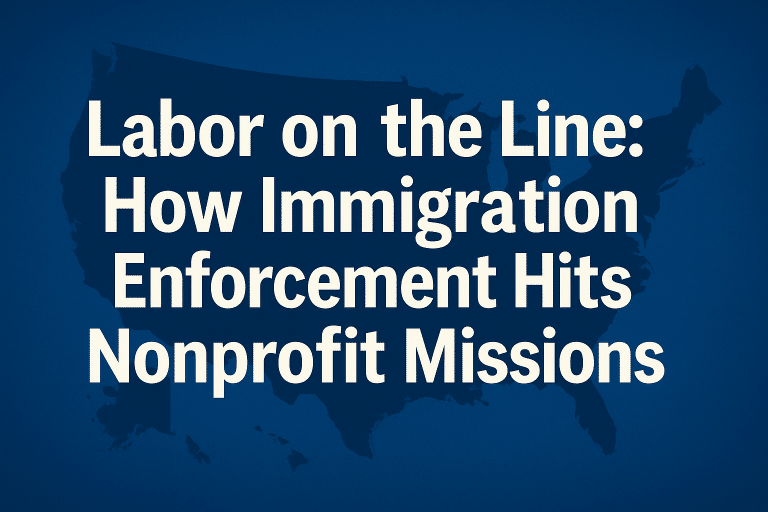As the U.S. tightens immigration policies, nonprofits face ripple effects across communities, services, and labor supply. Recent data shows over 1 million workers could be removed from the U.S. labor market in the next year—just when sectoral demands are spiking. From advocacy groups to social service providers, we need to understand and respond to this shift proactively.
Turning Up the Heat: From Targeted Audits to Widespread Enforcement
Earlier this year, federal agencies expanded enforcement beyond isolated investigations. ICE has resumed unannounced workplace raids in industries like hospitality, agriculture, and construction. Meanwhile, the Social Security Administration is reinstating “no-match” letters that flag Social Security Number discrepancies—even for long-term lawful workers—prompting confusion and heightened scrutiny. These factors create administrative walls that ripple out into nonprofit operations, especially those dependent on immigrant staff and contractors.
Where Workforce Gaps Will Deepen
-
Food Supply & Community Kitchens: Immigrant workers represent approximately 14 million of the food industry workforce—including meatpacking and farm labor sectors Source. Reduced staffing threatens emergency food distribution and supply-chain resilience.
-
Healthcare & Caregiving: Nonprofits running home care, respite services, and bilingual clinics depend on immigrant aides. Barron’s cautions that caregiving shortages will drive overtime, burnout, and waitlists.
-
Education & Youth Support: Community schools and after‑school programs employ foreign-born staff in essential roles. Data from California showed after ICE raids, private-sector employment dropped 3.1%, and student absenteeism jumped 22–30%.
3. Economic & Organizational Fallout
-
Supply Shock & Inflation: Reuters notes that ending Temporary Protected Status for 900k+ individuals could remove around 1.1 million workers (0.8% of the U.S. labor force), with ripple effects on GDP, particularly in labor-intensive fields.
-
Sector Slowdowns: Wells Fargo reports that foreign-born workforce shrinkage—150,000 between February and June 2025—leads to “historically tight” hiring conditions.
-
Funding Stress: With fewer workers in food and healthcare, nonprofits may see rising operational costs and volunteer burnout, straining budgets and reducing reach.
4. Nonprofit Response: Advocacy, Adaptation, Resilience
-
“Know Your Rights” & Legal Clinics: The nonprofit sector has ramped up workshops, hotlines, and legal support for employees fearing ICE or SSA actions.
-
Cross-Training & Strategic Staffing: Agencies are cross-training staff to cover essential roles, building flexible volunteer cohorts, and partnering with temp networks for emergency staffing.
-
Coalition Advocacy: Groups are calling for “safe-harbor” compliance windows and real-time I-9 platforms to ease documentation burdens.
5. Policy Changes Being Explored
-
Expanding Visa Programs: Proposals include raising H-2A/B caps and fast-tracking caregiver visas.
-
Modernizing Verification: Advocates support creating a unified federal portal for work authorization to reduce mismatches and delays.
-
Earned Legalization: Some stakeholders are pushing for legal status pathways for long-term, law-abiding workers to stabilize communities.
6. Human Consequences
-
Fear & Displacement: ICE actions drive families into hiding—undermining trust and increasing reliance on nonprofits for basic needs.
-
Service Disruptions: Sudden worker departures stall critical programming in health, housing, and education.
-
Community Breakdown: As staff and volunteers leave, nonprofits lose cultural bridges and institutional knowledge.
7. What Nonprofits Should Do
Immediate Tactics
-
Create staff-only protocols for responding to ICE or SSA visits.
-
Audit I-9 and payroll records proactively—and provide staff legal guidance.
-
Build cross-training plans and reserve volunteer back-ups.
Long-Term Moves
-
Offer retention incentives—flex hours, stipends, benefits.
-
Partner with workforce boards and colleges to bring in local talent for multilingual frontline roles.
-
Join advocacy coalitions pushing for balanced immigration policy and safer verification systems.
What we know
Nonprofits have always been lifelines in uncertainty. But the current immigration policy emphasis threatens to cut the very hands that keep services running—from community kitchens to school programs. Embracing readiness, resilience, and advocacy is critical now. By supporting workers, strengthening compliance, and working policy channels, the sector can sustain impact—and relay one powerful message to lawmakers: community well‑being depends on workforce security.
Frequently Asked Questions: The Impact of Immigration Crackdowns on the Nonprofit Workforce
1. How many workers could be affected by recent immigration enforcement changes?
Estimates suggest over 1 million workers—across both undocumented and visa-dependent populations—could exit the U.S. labor force over the next year due to stricter enforcement, revised verification procedures, and canceled protections like Temporary Protected Status (TPS) [Reuters, 2025].
2. What does this mean for nonprofits specifically?
Nonprofits are deeply reliant on immigrant labor, especially in caregiving, education support, food access, and outreach roles. Staff shortages in these areas can delay programs, overextend existing teams, and limit service capacity.
3. Which roles are most at risk in nonprofit organizations?
Frontline positions like home health aides, kitchen staff, interpreters, program associates, and janitorial or facilities workers are often filled by immigrants. These roles are difficult to fill quickly due to language, experience, or certification barriers.
4. What are “no-match” letters and why do they matter now?
“No-match” letters are sent by the Social Security Administration to employers when an employee’s name and SSN don’t match government records. They’ve returned in 2025 and are creating confusion and compliance pressure—even when discrepancies stem from clerical errors.
5. How are nonprofit employers expected to respond to ICE visits or audits?
Nonprofits must ensure internal compliance without violating worker rights. This includes designating a compliance lead, avoiding over-reporting, securing legal counsel, and preparing a clear protocol in the event of an ICE visit.
6. What legal risks do nonprofits face if they employ undocumented workers unknowingly?
Organizations may face fines or contract terminations if found noncompliant with Form I-9 or E-Verify requirements. However, there are legal protections for employers who can demonstrate good-faith compliance efforts.
7. What can be done to protect immigrant staff and volunteers?
Nonprofits can offer “Know Your Rights” trainings, connect staff with legal aid, and clarify policies around documentation, confidentiality, and ICE procedures. Some also offer stipends for legal screenings or translation services.
8. Are there any proposed policy solutions to ease this labor strain?
Yes. Proposals include expanding H-2B and caregiver visas, modernizing the federal work verification system, and creating earned legalization pathways for long-standing, law-abiding workers who fill essential roles.
9. How should nonprofits adjust hiring and retention strategies?
Strengthen retention with fair pay, predictable scheduling, and support services. Consider partnerships with workforce boards, community colleges, or immigrant-serving organizations to recruit and train local talent.
10. Where can we turn for guidance and support?
Organizations like the National Immigration Law Center, American Immigration Council, and local legal aid societies offer guidance. You can also collaborate with HR associations, advocacy coalitions, and trusted staffing partners to stay informed and prepared.
Sources
This post draws on findings from recent reporting and data:
-
Reuters on TPS endings and workforce loss Reuters
-
Wells Fargo economist insights on immigrant workforce decline nypost.com+15hrdive.com+15politico.com+15
-
The Guardian on food industry dependence The Guardian
-
SF Chronicle and Stanford on California raids effects i-9intelligence.com+3San Francisco Chronicle+3en.wikipedia.org+3
-
SSA no-match facts i-9intelligence.com+5Fisher Phillips+5Klasko Immigration Law Partners, LLP+5
-
Nonprofit compliance trends and public sentiment washingtonpost.com
Disclaimer:
This article is intended for informational purposes only and does not constitute legal advice. Foundation List is not a law firm and does not provide legal counsel. We encourage readers to consult with qualified immigration or employment law professionals for guidance specific to their organization, workforce, or circumstances. All data and policy references are current as of publication but may be subject to change. Foundation List does not take a political position on immigration policy or enforcement. Our aim is to support the nonprofit community by sharing relevant information that may impact workforce planning and service delivery.


